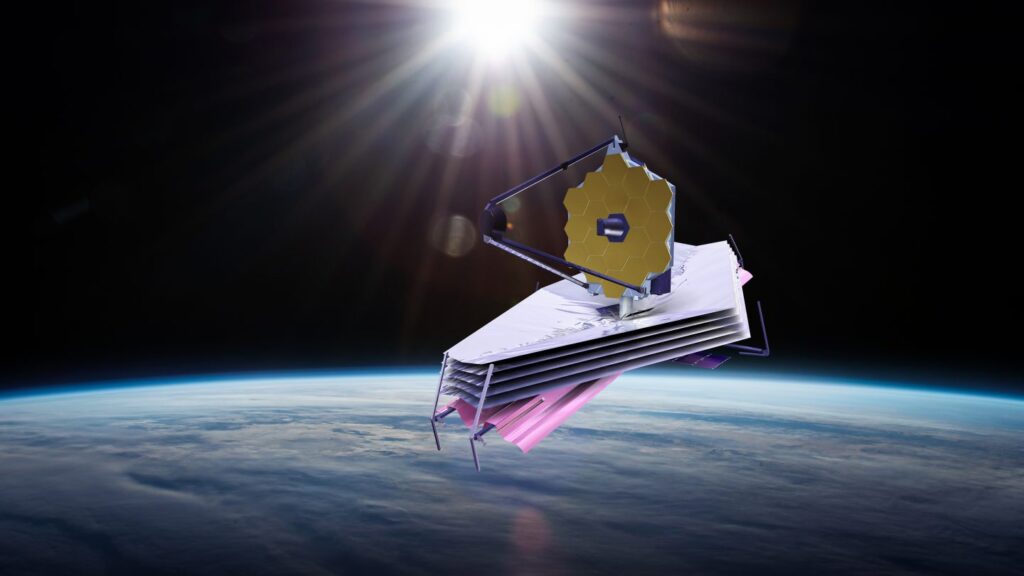NASA Reveals James Webb Telescope’s First Cosmic Targets To Include Distant Galaxies, Nebulae, And More:
The James Webb Space Telescope, a joint project of NASA, ESA, and CSA, will soon reveal unequaled and in-depth views of the cosmos with the impending publication of its first full-color images and spectroscopic data. The US, European, and Canadian space agencies are preparing for a dramatic presentation of early observations by the $10 billion (approximately Rs. 79,330 crores) observatory, which is slated to disclose fresh insights into the origins of the universe on July 12.
An international panel chose the Southern Ring Nebula, which surrounds a dying star 2,000 light-years away, and the Carina Nebula, a gigantic cloud of gas and dust situated 7,600 light-years away, to be included in the first collection of full-color scientific images. One of the iconic towering pillars that makes up the Carina Nebula is the three-light-year-tall “Mystic Mountain,” a celestial peak that Hubble is credited with photographing.
Webb has also performed spectroscopy on the distant gas giant WASP-96 b, which was discovered in 2014. Spectroscopy is an analysis of light that provides comprehensive information. WASP-96 b is around 1,150 light-years from Earth and has a mass that is almost half that of Jupiter. It also orbits its star in about 3.4 days.

The next object is Stephan’s Quintet, a tiny galaxy 290 million light-years away. The list of cosmic objects that Webb chose for these initial observations is provided here. It will be made public on Tuesday, July 12 at 10:30 a.m. EDT during NASA’s live broadcast. Each image will simultaneously be made available on social media and the agency’s website.
The targets mentioned below constitute the observatory’s first wave of full-color scientific photos and spectra, as well as the official start of Webb’s general science activities. An international committee including members from NASA, ESA, CSA, and the Space Telescope Science Institute chose them.
• The Carina Nebula: The Carina Nebula, located around 7,600 light-years away in the southern constellation Carina, is one of the largest and brightest nebulae in the sky. Stars are born in stellar nurseries called nebulae. Many huge stars several times the size of the Sun can be found in the Carina Nebula.
• WASP-96 b (spectrum): WASP-96 b is a huge gas-filled planet located beyond our solar system. The planet is approximately 1,150 light-years away from Earth and orbits its star every 3.4 days. It was discovered in 2014 and has nearly half the mass of Jupiter.
• The Southern Ring Nebula: It is also known as the “Eight-Burst” nebula, is a planetary nebula, which is an expanding cloud of gas that surrounds a dead star. It has a diameter of roughly half a light-year and is about 2,000 light-years away from Earth.
• Stephan’s Quintet: Stephan’s Quintet is located in the constellation Pegasus, approximately 290 million light-years away. It is noteworthy for being the first compact galaxy group found in 1877. Four of the quintet’s five galaxies are entangled in a cosmic dance of frequent close encounters.
• SMACS 0723: Massive foreground galaxy clusters amplify and deform the light of objects behind them, enabling a deep field view into both the extremely far-off and fundamentally dim galaxy populations.
Webb can look farther back in time to the Big Bang, which occurred 13.8 billion years ago, as compared to any instrument before it thanks to its infrared capabilities.
Webb is able to detect the first stars’ light with an unparalleled level of resolution as it transitions from the shorter ultraviolet and visible wavelengths it originally emitted into longer infrared wavelengths as the cosmos expands.
The publication of these initial photographs signals the official start of Webb’s research activities, which will continue to investigate the mission’s core scientific issues. Teams have already applied for time to utilize the telescope in its first “cycle,” or year of observations, through a competitive process.
The James Webb Space Telescope is the world’s leading observatory for space science. Webb will investigate mysteries in our solar system, as well as distant worlds orbiting other stars, and will investigate the intriguing architecture and origins of our universe and our place in it.

I am a second-year student pursuing Liberal Arts from Nmims. I am a painter, I love reading and have a great interest in cooking. I am also a trained kickboxer. I’ve always had a passion for writing and hence in my free time, I work as a freelance writer.